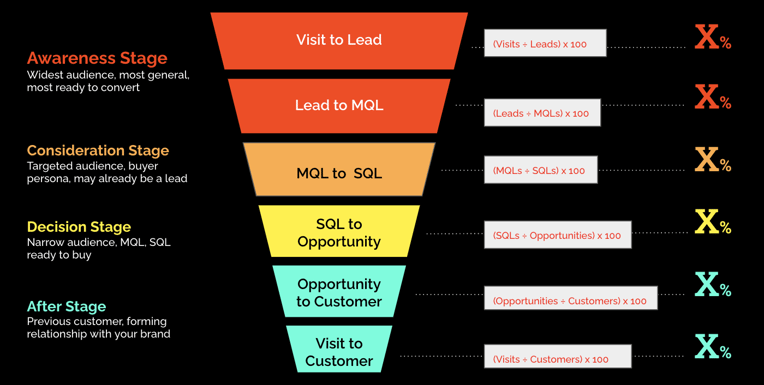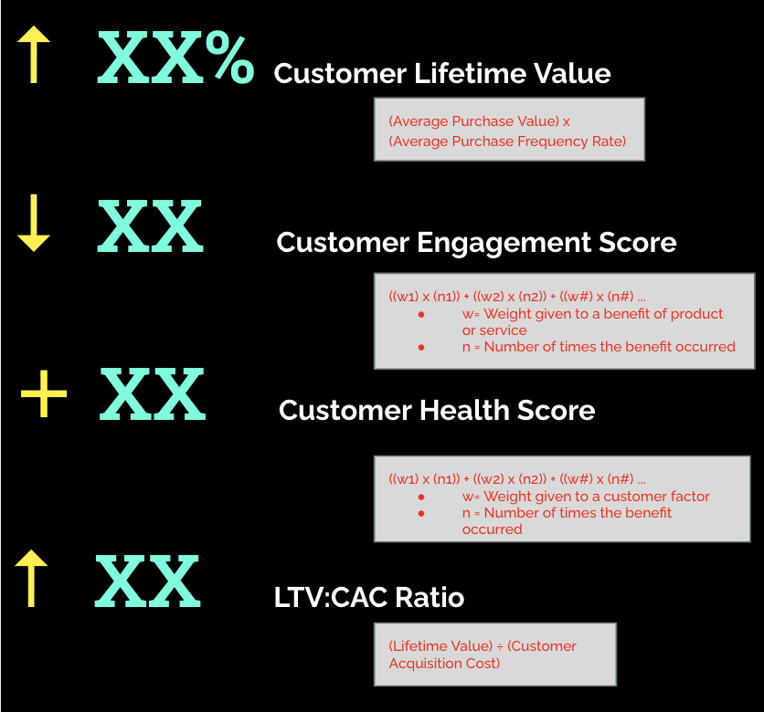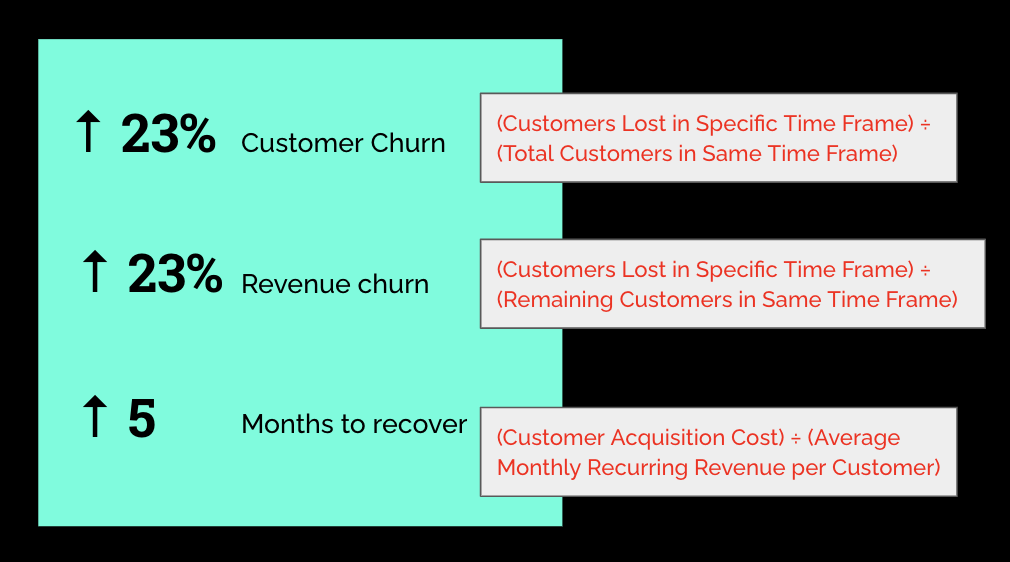
How to Identify the Most Impactful SaaS Marketing Metrics to Take to the Board
September 11, 2020
Long past are the days when marketing was just the team that “made things look pretty.” SaaS marketers today are expected to deliver—and document—real business value for their efforts. And nowhere is effectively reporting on marketing performance more important than in the board meeting!
The board meeting is no time for vanity metrics—you know that. So rather than talking about Facebook likes and shares, what marketing metrics will you focus on? Here are a few ideas to get you started.
1. Pipeline and Acquisition Metrics
For most SaaS companies, revenue is heavily dependent not just on new customers but also on cross-selling and upselling to the existing customer base. That means SaaS marketers will want to report on impact and cost-effectiveness across the entire customer lifecycle.
Conversion Rates at Each Stage
The board wants to see that you have an efficient marketing machine that effectively converts at each stage. Focus on showing conversion rates from each stage to the next, and be prepared with industry benchmarks. This exercise will also help you identify gaps and areas for improvement (and then showcase those improvements and how they translate into more customers and revenue!).

(Source)
Marketing-Generated Pipeline
At my previous SaaS company, marketing was responsible for generating more than a third of the company’s new pipeline. So one of the most important metrics for us to report on to the board was the percentage of the pipeline generated by marketing (no prior sales involvement) and our progress toward that overall pipeline goal.
If these targets have not been established at your company, consider improving sales and marketing alignment with clear expectations (and numbers) regarding who’s responsible for delivering what.
What does the board want to know?
Is marketing doing its part in generating a significant portion of the sales pipeline? And, maybe even more importantly, are we on target to reach our pipeline goals, which ultimately will determine if we reach our sales and revenue goals?
2. Cost per Lead
To determine your cost per lead (CPL), divide your marketing spend by the number of leads to see what your marketing efforts are costing you. Better yet, calculate your cost per lead per channel so you can not only benchmark (and work to improve) your CPL but also identify your most cost-effective channels and divert your effort and budget there.
What does the board want to know?
How much are you spending to bring in leads, and what channels are getting us the “best bang for our buck”?
For example, you may be able to demonstrate that digital channels such as your website and inbound marketing deliver a much lower cost per lead than more traditional (and expensive) channels such as trade shows. Use this data to make the case for funneling more dollars to the channels that work best!
3. Cost of Customer Acquisition
Take CPL a step further with cost of customer acquisition (CoCA). For SaaS companies, it may take years for recurring revenue to begin to outweigh the cost of acquisition, so it’s important to monitor and work to decrease these costs.
What does the board want to know?
Simple: What is our CoCA, and is it improving?
The board wants to know not only what it costs to get a lead, but also the combined sales and marketing costs required to close a new deal compared to the expected revenue. Add the sales and marketing costs and then divide by the number of new customers to reach this number.
Additionally, consider using revenue attribution reporting to identify and share the channels or even specific pieces of content that are delivering the most revenue for the business. This is a great spot to highlight marketing wins!
4. Average Monthly Recurring Revenue
Monthly recurring revenue (MRR) refers to the earnings per month for all active customers. For SaaS companies operating on a subscription model, this recurring revenue is even more important than the initial sale.
To make the most of this metric, you’ll want to break MRR down by revenue source or type of customer. For example, what type of subscription or product does the customer have? This can help you identify pockets of opportunity, such as a chance to upsell a certain add-on to your existing clients.
What does the board want to know?
What is our MRR, and what sources and types of customers are delivering the most revenue? This will help identify where there’s the greatest opportunity to accelerate that revenue stream or ramp up an alternative stream that is not delivering.
5. Customer Revenue and Retention Metrics
As we’ve discussed, the entire customer lifecycle, both pre- and post-purchase, is important to measuring marketing performance. You’ll want to consider a number of key metrics that represent the average amount of revenue each customer can be expected to provide, as well as the current status and likelihood of customer retention or churn.
Customer Lifetime Value
Customer lifetime value (LTV) represents the total amount of revenue a company can expect to generate from a single customer account.
Customer Engagement Score
The customer engagement score is used to measure how engaged your customers are based on the benefits that your product or service is providing to them.
Customer Health Score
The customer health score is used to measure how satisfied your customers are. Health scores can differ per company and can include a variety of factors, from activity level and customer feedback to billing history. Scores can also be segmented by customer type.
LTV:CAC Ratio
The LTV:CAC ratio will help your company determine how much you need to be spending to acquire a customer. The ideal ratio is around 3-to-1.

(Source)
What does the board want to know?
How are we doing and what can we expect in the future when it comes to revenue, acquisition costs and customer health? What’s our action plan to stay on track or improve?
6. Churn Metrics
Customer retention and satisfaction are core to a SaaS company’s recurring revenue model, which means keeping customer churn low is key as well. Fewer customers mean less recurring revenue and fewer people to sell additional services to.
What does the board want to know?
Keep the board updated on the proportion of contractual customers or subscribers who leave during a given time period. In addition, you’ll want to share that same metric in terms of lost revenue and include the amount of time it will take to recover. Marketing can play an important part in customer engagement, and these metrics will help you tell that story.

(Source)
Don’t forget to include next steps with every key marketing metric! Data can help you tell a story and then follow up with concrete actions your team can take to improve each of these metrics.

About the author
Ali Orlando Wert was formerly a Director of Marketing Strategy at SmartBug responsible for the strategy, execution, growth and goal achievement of her key accounts. She leads a cross-functional team of specialists in implementing strategic inbound marketing, digital marketing, marketing automation, paid media, sales enablement, conversion rate optimization, SEO, web development, social media and offline channels. Ali is a winner of CMA's Project of the Year and Best Content Marketing Program as well as a speaker at Content Marketing World and ContentTECH. Read more articles by Ali Orlando Wert.

















.png?width=200&height=260&name=Ultimate%20Guide%20to%20Hiring%20an%20Agency%20(11).png)



